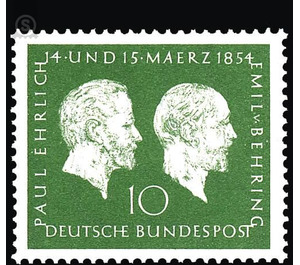100th birthday by Prof. Paul Ehrlich and Emil von Behring - Germany / Federal Republic of Germany 1954 - 10 Pfennig
Theme: Calender
| Country | Germany / Federal Republic of Germany |
| Issue Date | 1954 |
| Face Value | 10.00 |
| Color | green |
| Perforation | K 13 1/2: 13 3/4 |
| Printing Type | offset |
| Stamp Type | Postage stamp |
| Item Type | Stamp |
| Chronological Issue Number | 87 |
| Michel ID | BRD 197 |
| Chronological Chapter | GER-BRD |
| SID | 202727 |
| In 42 Wishlists | |
From the 14th to the 16th of March, the memory of Paul Ehrlich and Emil v. Behrings be celebrated in a solemn manner, as on these days the birthdays of these two great researchers for the 100th Male. The works of Ehrlich and Behring have opened up new fields and methods of healing. Both researchers may be considered as the fathers of today's successful disease control: Honest by chemical substances, Behring by vaccines. Paul Ehrlich, born on March 14, 1854 in the Silesian town of Strehlen, first dealt with the coloring of living and dead tissue. Inspired by the work of Koch and Behring, he turned to the protective substances created in the blood after overcoming infectious diseases or toxicity and contributed significantly in this area to the exact determination of the protective value of modern standardization methods for drugs. His greatest act, however, was the realization of his idea of combating the pathogens of disease in the human body even with chemical substances that kill only the pathogens, without damaging the cells of the human body and its organs. Between 1904 and 1912 Behring produced a large number of arsenic preparations for the treatment of sleeping sickness, syphilis and various other diseases. The culmination of his work was the discovery of Salvarsan (Ehrlich Hata 606) and the Neosalvarsans. In 1908 he was awarded the Nobel Prize for medicine together with the bacteriologist Metschnikoff. The great researcher, whose memory is preserved by the Paul Ehrlich Institute in Frankfurt (Main), died on 20 August 1915. Emil v. Chr. Behring was born on March 15, 1854 in Hansdorf in the county of Rosenberg, West Prussia. In the course of his life he has made significant discoveries in the field of infectious diseases. At an early age he was concerned with the problem of the defense of the organism against toxins. He proved that e.g. a superseded diphtheria ensures full protection against a new infection. This protective property was tied to the blood. Further investigation showed that in blood serum protective substances called antioxins, i. Antidotes, were present. He succeeded in producing a serum that preventively and healing affects the human diphtheria. The introduction of diphtheria serum (1892) defeated the "choking angels of the children" and saved thousands of children's lives each year. Today, this disease has lost its horrors. Later, Behring developed the anticonvulsant antitoxin, which has been widely used as a tetanus serum, especially in both world wars. The culmination of his life's work was the introduction of the diphtheria and tetanus vaccination: Behring found that with the administration of attenuated poisons, the body itself develops the antitoxins that give it complete protection for many years to come. Emil v. Behring received on 12 December 1901 as the first Nobel Prize for Medicine. He died on March 31, 1917
| Condition | Name | In Stock | Price | Price + Shipping | Store | |
|---|---|---|---|---|---|---|
 | Used | 100th birthday by Prof. Paul Ehrlich and Emil von Behring - Germany / Federal Republic of Germany 1954 - 10 Pfennig | 9 | US $3.23 | US $6.46 |  FILATELIELOKET (0) FILATELIELOKET (0)Shipping US $3.22 |
 | Unmounted Mint ** | 100th birthday by Prof. Paul Ehrlich and Emil von Behring - Germany / Federal Republic of Germany 1954 - 10 Pfennig | 5 | US $4.85 | US $8.07 |  FILATELIELOKET (0) FILATELIELOKET (0)Shipping US $3.22 |


